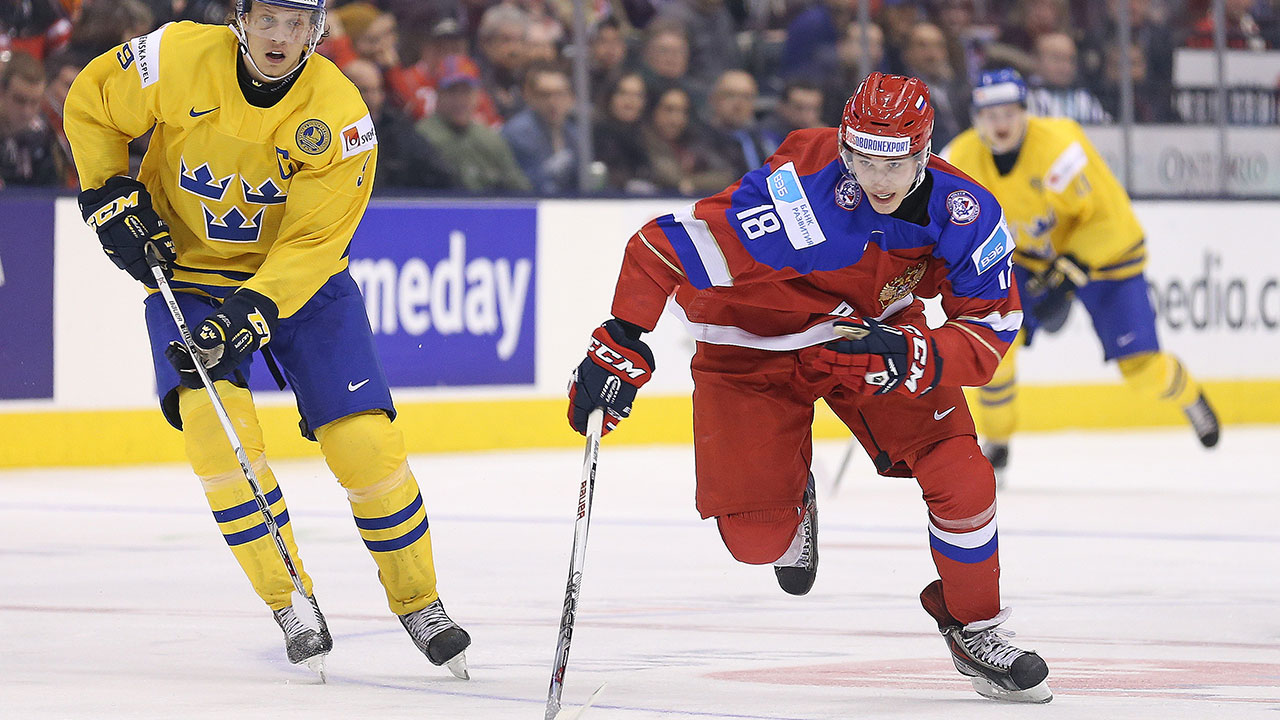From the first half dozen shifts or so, it seemed inevitable that the Russians were going to skate off with a win over Sweden in the World Junior Championship semifinal at the Air Canada Centre.
In the scouting ranks in recent years, the talk about the Russians focused not on inevitability but rather impossibility.
It was nearly impossible to pry young Russian players away from their KHL teams. Even if you pulled that off you weren’t done — if an NHL team thought that a young Russian player was going to be best served by development time in the AHL, they heard the siren call of the KHL. The money was there, all kinds of benefits, a comfort level with the culture.
You need only to look back at the 2010 world juniors in Buffalo where the Canadian juniors collapsed in the third period and Russia rallied to win an improbable gold medal game. The Canadian team was rife with players who are these days taking regular shifts in the NHL. The Russian team had two conspicuous talents, Vladimir Tarasenko and Evgeny Kuznetsov, who are emerging stars after being drafted in the first round by St Louis and Washington. The roster also had a skilled defenceman, Dmitry Orlov, another Capitals draft pick who made it to North America but is MIA these days; and a forward, Danil Sobchenko, who was drafted by San Jose but died in in the Lokomotiv plane crash. The Kings drafted a kid who came over briefly but took a spin around the ECHL and decided North America wasn’t for him. All others went back to Russia to play in the KHL after Buffalo (and partying in Buffalo) and haven’t been back this side of the Atlantic.
That’s really bad for hockey. Based on the games against Canada in the opening round and the final in the 2011 tournament, it looked like half a dozen of those kids who went back to the KHL could play with the likes of Ryan Johansen and his Canadian teammates.
“You couldn’t draft any of those [Russian] kids even if you liked them,” a NHL head scout remembered Saturday. “There were players but it came down to signability — you just couldn’t risk burning a pick. They were impossible to get out of Russia. If you could get their release you had to figure that you couldn’t compete with the KHL on dollars for entry-level kids, when you take in the costs, their salaries after tax and all the rest — if you could get them over, it wasn’t easy, and if they couldn’t play for you right away, they’d go back.”
The effect was something between a softening of the market for players from the Russian leagues and that market’s complete disappearance. In 2013 just five players were selected from KHL or Russian junior leagues: Valeri Nichuskin to Dallas at No. 10; Pavel Buchnevich in the third round to the Rangers; Bogdan Yakimov (who played a game with Oilers this year) and Pavel Slepyshev, both to Edmonton in the third; and defenceman Rushan Rafikov in the seventh round to Calgary.
(For the purposes of this story we’re separating players from the KHL from the Russians who have come over to play in the CHL, such as Nikita Zadorov, formerly of London, who Buffalo took at No. 16 overall in the 2013 draft. Those who had already come over weren’t considered easy pickings but simply more challenging to draft than, say, your garden-variety North American prospect.)
Nichushkin moved straight to the pros and Yakimov and Slepyshev are ’94 birthdays and thus too old for this tournament. But Buchnevich looked like a really useful, physical and skilled forward against the Swedes — great value for a third-rounder. And Rafikov is an energetic, hard-ass blueliner with decent skill, a steal in the seventh round if you can bring him over — which looks ever more likely.
In recent months the word has come down that the KHL was built on a false economy, state-buttressed for Sochi with no plan that’s sustainable in the long term. Bounced checks and skipped payments have caused an exodus of foreign players pulling down KHL money and the domestic talent would figure to be next.
How will the availability of Russians change the draft biz as we know it? Well for one, a bunch of the kids on this Russian team are out there for the drafting this June.
Setting aside the four Russians in this lineup who are playing for CHL teams and Nikolai Goldobin, whose rights were scooped by San Jose out of Sarnia last June, only three other KHL players in the Russian lineup here have been drafted by NHL teams: Nashville took forward Vladislav Kamenev in the second round even though the Preds suffered third-degree burns when handling Alexander Radulov; the Islanders took yesterday’s back-up goaltender Ilya Sorokin in the third; and the Rangers took the starting netminder, Igor Shestyorkin, in the fourth.
Bottom line: A lot of Russian kids in their second or third year of draft eligibility will be playing for their dinner against Canada in the final.
“It’s going to be great to talk about talent and not signability,” a scout said yesterday. “You know you’re going to have a chance. It’s a game changer.”
Although Nos 1 and 2 here have been drafted greater access to KHL players will likely have a greater effect in goal than anywhere else, at least in 2016.
“Maybe the best Russians coming down the line are goalies,” one NHL head scout said. “The Russian under-17 team came over and did a number on the U.S. team and their best players were their goalies. The talent might have been a wash, maybe a slight edge to Russia. But the U.S. just couldn’t find a way to beat the goalies.”
A net gain, when it used to be simply nyet.


